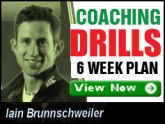Is your cricket lacking power?
Can power make you a better cricketer?
Absolutely, if you know how to develop these skills in the right way. In fact, having highly functional power at your command is the most important cricket fitness element there is.
Better batting is built on bulletproof concentration
I can't seem to get the South African first Test recovery out of my head. Most comments have been negative: That old fashioned defensive cricket does no good in this big hitting, big money world.
But batting out two full days for a draw requires almost superhuman concentration.
What South Africa's epic rearguard defence can teach your club team
Test cricket doesn't throw up a lot of old fashioned 'bat out for the draw' situations these days, but it's something club cricketers face with regularity.
Your team might only need to last 50 or so overs to rescue a draw, imagine how hard it would be to see off 160. The South African second innings in the first Test against England was an education in how to save the game.
Preseason training
There are a number of elements that anyone intending to play grade cricket should be addressing in the pre-season period. Some are specific to the roles you fulfil in a team (batsman, spinner, seamer, quick…) while while others need to be addressed by everyone. I will discuss them under a number of particular headings:
Fitness·
Is your cricket mindful or mindless?
One difficult piece of coaching advice is this: Play one ball at a time.
It's a simple way to put the concept of mindfulness.
Mindfulness is the ability to stay in the moment with your thoughts and actions despite external distractions. In all cricket disciplines this is a skill that is more than handy. You are calm under pressure and less likely to make mistakes as a bowler, batsman or fielder.
What's the perfect body weight for cricket?
From the impressive girth of Dwayne Leverock to the diminutive skills of Sachin, there are few sports than can incorporate the full range of shapes and sizes that cricket does. Nevertheless, there are certain ideal elements that everyone can aspire to.
What are these elements?
What to do if you can't do chin ups
Chin ups are an essential part of any cricketer's training programme and have the advantage of being able to be done almost anywhere, but many players avoid them.
It's easy to understand why. They are hard to do.
Why bother looking foolish on the chin up bar when you can do a few more sets of bicep curls to make the guns look great?
Fielding Drills: Decision Maker
Purpose: To practice judging and catching high balls.
Description: The coach (c) hits high catches in between the two lines. Players have to judge who is best placed to catch the ball and call for it. Once caught the ball is throw back to the wicketkeeper.
Lines swap over halfway through the session.
Take command of your diet: 4 fish-free ways of getting more omega 3
You are trying to get more omega 3 in your diet right?
Boffins in white coats have been looking at the benefits of this fat for years and the evidence is clear: Everyone can benefit from omega 3, especially those who play sport at any level.
Static vs Dynamic Stretching - When to use each
Static stretching exercises, in which you're not moving around at all but are simply elongating a particular muscle or group of muscles, do have a place in your training program, but their value and proper usage are often misunderstood.
It's probably best to place your static stretches at the end of your workout as part of the cool-down, not at the beginning of a training session. Static exercises help bring your body back toward a state of rest and recovery and allow you to relax and lengthen the muscles that you have put under stress during your workout.





















